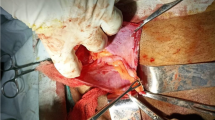Abstract
Background
Laparoscopic surgery is a good alternative to the open technique for treating hernias in female paediatric patients. The laparoscopically inverted and sutured hernia sac forms a nodule, the long-term fate of which has not been previously studied radiologically.
Objective
To describe the early and delayed US changes after laparoscopic inversion and suturing of paediatric female inguinal hernias.
Materials and methods
Twenty girls (age 1.5 months to 12 years; median 4.6 years) who underwent laparoscopic inguinal hernia repair were prospectively evaluated with US the day before and the day after the procedure. Delayed scans were obtained at 1, 6 and 12 months.
Results
The laparoscopic procedure involved inversion and suturing of the hernia sac, which resulted in a nodule that plugged the internal inguinal ring and resembled a rosebud laparoscopically. US detected the 'rosebud' in all cases on the first postoperative day. Initially appearing as a rounded or ovoid mass with a slightly hypoechoic texture, the 'rosebud' became progressively smaller, more hypoechoic and more lobulated on follow-up. It disappeared in all but two cases at 6 months and in all cases at 1 year. There was no US evidence of recurrence.
Conclusions
The 'rosebud' formed by this laparoscopic procedure displays typical US features and temporal changes.






Similar content being viewed by others
References
Chou TY, Chu CC, Diau GY, et al (1996) Inguinal hernia in children: US versus exploratory surgery and intraoperative contralateral laparoscopy. Radiology 201:385–388
Rosenberger RJ, Loewereck H, Meyer G (2000) The cutaneous nerves encountered during laparoscopic repair of inguinal hernia. Surg Endosc 14:731–735
Spaw AT, Ennis BW, Spaw LP (1991) Laparoscopic hernia repair: the anatomic basis. Laparoendosc Surg 1:269–277
Schier F (1998) Laparoscopic herniorrhaphy in girls. J Pediatr Surg 37:1495–1497
Schier F, Montupet P, Esposito C (2002) Laparoscopic inguinal herniorrhaphy in children: a three-center experience with 933 repairs. J Pediatr Surg 37:395–397
Gorsler CM, Schier F (2003) Laparoscopic herniorrhaphy in children. Surg Endosc 17:571–573
Erez I, Rathause V, Vacian I, et al (2002) Preoperative ultrasound and intraoperative findings of inguinal hernias in children: a prospective study of 642 children. J Pediatr Surg 37:865–868
Chen KC, Chu CC, Chou TY, et al (1998) Ultrasonography for inguinal hernias in boys. Pediatr Surg 33:1784–1787
Toki A, Watanabe Y, Sasaki K, et al (2003) Ultrasonographic diagnosis for potential contralateral inguinal hernia in children. J Pediatr Surg 38:224–226
Kervancioglu R, Bayram MM, Ertaskin I, et al (2000) Ultrasonographic evaluation of bilateral groins in children with unilateral inguinal hernia. Acta Radiol 41:653–657
Lawrenz K, Hollman AS, Carachi R, et al (1994) Ultrasound assessment of the contralateral groin in infants with unilateral inguinal hernia. Clin Radiol 49:546–548
Nagar H, Kessler A, Graif M (1999) The role of ultrasound in the diagnosis of stitch granulomas following paediatric herniotomy. Pediatr Radiol 29:803–806
Furtschegger A, Sandbichler P, Judmaier W, et al (1995) Sonography in the postoperative evaluation of laparoscopic inguinal hernia repair. J Ultrasound Med 4:679–684
Peiper C, Ponschek N, Truong S, et al (2000) Ultrasound-based volumetric evaluation of fluid retention after inguinal hernia repair. Surg Endosc 14:666–669
Dilek ON, Bozkurt M, Arslan H, et al (1997) Herniography and ultrasonography. A prospective study comparing the effectiveness of laparoscopic hernia repair with extraperitoneal balloon dissection. Surg Endosc 11:29–31
Hergan K, Scheyer M, Oser W, et al (1995) The normal CT and ultrasonic findings after a laparoscopic inguinal hernia operation. Rofo Fortschr Geb Rontgenstr Neuen Bildgeb Verfahr 162: 29–32
Author information
Authors and Affiliations
Corresponding author
Rights and permissions
About this article
Cite this article
Akansel, G., Guvenc, B.H., Ekingen, G. et al. Ultrasonographic findings after laparoscopic repair of paediatric female inguinal hernias: the 'vanishing rosebud'. Pediatr Radiol 33, 693–696 (2003). https://doi.org/10.1007/s00247-003-0976-8
Received:
Revised:
Accepted:
Published:
Issue Date:
DOI: https://doi.org/10.1007/s00247-003-0976-8




